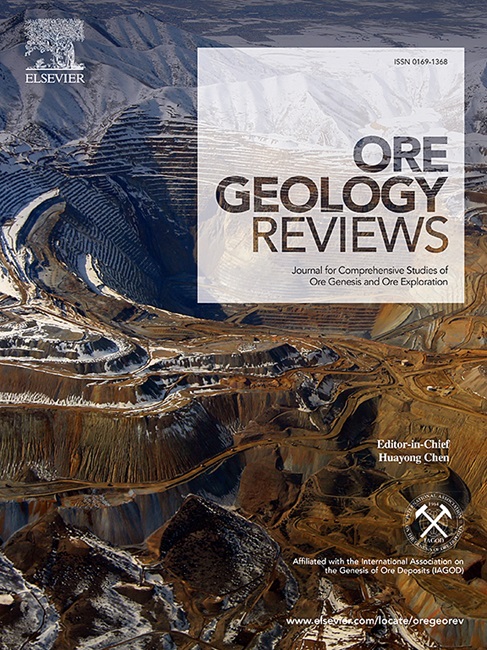Hydrothermal rutile as a pathfinder for discriminating overprinted magmatic-hydrothermal gold and molybdenum mineralization: The giant Laowan Au deposit, Tongbai orogen, Central China
IF 3.6
2区 地球科学
Q1 GEOLOGY
引用次数: 0
Abstract
The Laowan deposit is a recently discovered large lode-gold deposit with a Au reserve >208 t in the Tongbai Orogen of Central China. This Au deposit is characterized by the co-occurrence of stockwork-type Mo mineralization. Hydrothermal rutiles are present both in the altered rock-type gold ores and in the alteration halos around the fluorite-K-feldspar-quartz Mo veins. A detailed investigation of the mineralogical, textural, and chemical analyses (EPMA and LA–ICP–MS) of the Au- and Mo-related rutiles was carried out in this study. Au-related rutiles formed during silicification and sericitization, intergrown with a hydrothermal mineral assemblage of pyrite + chalcopyrite + electrum + sericite + quartz + calcite + REEPO4 minerals, whereas Mo-related rutiles formed during sericitization and silicification closely associated with sericite + quartz + apatite + calcite + molybdenite + other Fe-Cu sulfides. Both rutiles formed via hydrothermal breakdown of metamorphic titanites in the host rocks of garnet-epidot-amphoble–quartz schist. The formation mechanism involves coupled dissolution-reprecipitation of CaTiSiO5 (titanite) + CO2-rich fluid = TiO2 (rutile) + CaCO3 (calcite) + SiO2. The textural features show that most of the Au-related rutiles nucleate and grow at the original textural position of the precursor titanites, suggesting a mechanism of coupled dissolution and in situ precipitation due to relatively low mobility of Ti. The Mo-related rutiles grow in a microenvironment locally enriched in Ti due to the small-scale mobilization of Ti released during titanite dissolution, suggesting a relatively high solubility of Ti. These results indicate that the Mo-mineralized fluid system probably contains more halogens (particularly F) than the Au-mineralized fluid system does because TiO2 solubility and mobilization increase with increasing halogen concentration in the fluid system. The Au-related rutiles are characterized by enrichment of W, Nb, and Ta, whereas the Mo-related rutiles are characterized by enrichment of Sn, W, and Nb. The mass balance estimation indicated that the Au-related rutiles retained most of the trace elements released from the breakdown of titanites and significantly incorporated W and, to a lesser extent, Nb and Ta from the hydrothermal fluid during rutile precipitation. The Mo-related rutiles incorporated significant amounts of Sn, W, Nb, and, to a lesser extent, Th and Pb from the hydrothermal fluid and Sc, V and Cr from other mafic minerals, such as amphibole, during hydrothermal alteration. The compositional fingerprints of hydrothermal rutiles indicate that the Mo-mineralized fluid contained Sn, W and Nb and more halogen (particularly F), which are distinguished from the Au ore-forming fluid, which contained significant amounts of W but less Nb and Ta and lower amounts of halogen. The Au- and Mo-related rutiles formed from two different fluid systems during different periods (∼140 Ma and ∼130 Ma), recording the overprinting of two separate magmatic-hydrothermal fluid events in the same deposit.

热液金红石是判别岩浆-热液叠加金钼矿化的探路者:中国中部桐柏造山带巨大的老湾金矿床
老湾矿床是最近在华中桐柏造山带发现的一个大型原生金矿床,金储量达 208 吨。该金矿床的特点是同时存在堆积型钼矿化。在蚀变岩型金矿石和萤石-长石-石英钼矿脉周围的蚀变晕中都存在热液金红石。本研究对与金和钼有关的金红石的矿物学、纹理和化学分析(EPMA 和 LA-ICP-MS)进行了详细调查。与金有关的金红石在硅化和绢云母化过程中形成,与黄铁矿+黄铜矿+电黄铜矿+绢云母+石英+方解石+REEPO4矿物的热液矿物组合相互交错;而与钼有关的金红石在绢云母化和硅化过程中形成,与绢云母+石英+磷灰石+方解石+辉钼矿+其他铁-铜硫化物密切相关。这两种金红石都是在石榴石-橄榄石-闪长岩-石英片岩的母岩中通过热液分解变质榍石形成的。形成机制包括 CaTiSiO5(榍石)+富含二氧化碳的流体 = TiO2(金红石)+CaCO3(方解石)+SiO2 的耦合溶解-再沉淀。纹理特征表明,大多数与金有关的金红石都是在前驱体榍石的原始纹理位置成核和生长的,这表明由于钛的流动性相对较低,其机制是溶解和原位沉淀耦合。由于钛铁矿溶解过程中释放的 Ti 的小规模移动,Mo 相关金红石在局部富含 Ti 的微环境中生长,这表明 Ti 的溶解度相对较高。这些结果表明,钼矿化流体体系可能比金矿化流体体系含有更多的卤素(尤其是 F),因为随着流体体系中卤素浓度的增加,TiO2 的溶解度和迁移率也会增加。与金有关的金红石的特点是富含 W、Nb 和 Ta,而与钼有关的金红石的特点是富含 Sn、W 和 Nb。质量平衡估算表明,与金有关的金红石保留了钛铁矿分解过程中释放的大部分微量元素,并在金红石沉淀过程中从热液中大量掺入了W,其次是Nb和Ta。与钼有关的金红石在热液蚀变过程中大量掺入了热液中的锡、钨、铌,少量掺入了热液中的钍和铅,以及闪石等其他黑云母矿物中的锑、钒和铬。热液金红石的成分指纹表明,钼矿化流体含有Sn、W和Nb以及更多的卤素(尤其是F),这与金矿形成流体不同,后者含有大量的W,但Nb和Ta含量较少,卤素含量也较低。与金和钼有关的金红石形成于不同时期(140 Ma ∼和 130 Ma ∼)的两个不同流体系统,记录了同一矿床中两个独立的岩浆-热液流体事件的叠加。
本文章由计算机程序翻译,如有差异,请以英文原文为准。
求助全文
约1分钟内获得全文
求助全文
来源期刊

Ore Geology Reviews
地学-地质学
CiteScore
6.50
自引率
27.30%
发文量
546
审稿时长
22.9 weeks
期刊介绍:
Ore Geology Reviews aims to familiarize all earth scientists with recent advances in a number of interconnected disciplines related to the study of, and search for, ore deposits. The reviews range from brief to longer contributions, but the journal preferentially publishes manuscripts that fill the niche between the commonly shorter journal articles and the comprehensive book coverages, and thus has a special appeal to many authors and readers.
 求助内容:
求助内容: 应助结果提醒方式:
应助结果提醒方式:


